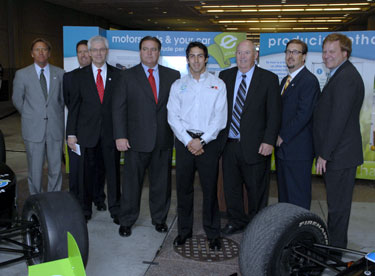Officials from the Chicago Board of Trade (CBOT) joined with government officials and representatives from the IndyCar Series and the ethanol industry on Monday in a tribute to the “Greening of Racing.”

Pictured from left to right are Terry Angstadt, IndyCar Series president; CBOT Executive Vice-President for Marketing and Business Development Chris Malo; USDA Under Secretary for Rural Development Thomas Dorr; CBOT Chairman Charlie Carey, Team Ethanol car driver Jeff Simmons; Illinois Director of Agriculture Chuck Hartke; EPIC Executive Director Tom Slunecka; and Doug Scott, Director of the Illinois Environmental Protection Agency.
Prior to the opening bell, CBOT Executive Vice-President for Marketing and Business Development Chris Malo talked about how the commodity exchange created ethanol contracts two years ago as a price discovery tool for the industry.
“When we launched our ethanol futures contract in March 2005 we knew we were early to the market place,” said Malo. “However, we recognized the increasingly important role that ethanol can play in meeting the nation’s energy needs before ethanol became a daily news story.”
U.S. Department of Agriculture Undersecretary for Rural Development Thomas C. Dorr played a part in the tribute, detailing the enormous growth of the ethanol industry.
“Ethanol production in 2000 was 1.6 billion gallons, today its six billion gallons and new capacity under construction will add another 6.4 billion gallons,” said Dorr. “Cellulosic ethanol will give us the potential to supply a third or more of our liquid fuels.”
Tom Slunecka, Executive Director of the Ethanol Promotion and Information Council (EPIC) said that ethanol has become more than just a product. “Ethanol is a movement,” he said. Besides being proud to partner with the Indy Racing League, Slunecka says EPIC is “proud to partner with the American consumer to help change our future.”
Terry Angstadt, IndyCar Series president, says the partnership with ethanol fits in perfectly with their mission.
“The Indianapolis Motor Speedway was built in 1909 literally as a test track to support the auto industry in technology and innovation,” he said. “That’s why the association with the ethanol industry, EPIC, the Rahal Letterman race team, Jeff Simmons is a perfect association for a business and series that is so aligned with technology and innovation as our cornerstone.”
 The project, a state of the art dental center located in the city of Connersville, Indiana — The Christie Family Dentistry — featuring some of the most technologically advanced dental equipment, will now be the first in the state to be powered by solar energy with this newly installed 20-kilowatt solar roof. This 20-kilowatt system will be one of the largest photovoltaic projects in Indiana and will provide up to one-half of the facility’s power requirements. This will be the first solar installation in Indiana to utilize solar roof tiles instead of standard panels.
The project, a state of the art dental center located in the city of Connersville, Indiana — The Christie Family Dentistry — featuring some of the most technologically advanced dental equipment, will now be the first in the state to be powered by solar energy with this newly installed 20-kilowatt solar roof. This 20-kilowatt system will be one of the largest photovoltaic projects in Indiana and will provide up to one-half of the facility’s power requirements. This will be the first solar installation in Indiana to utilize solar roof tiles instead of standard panels. 

 The
The 